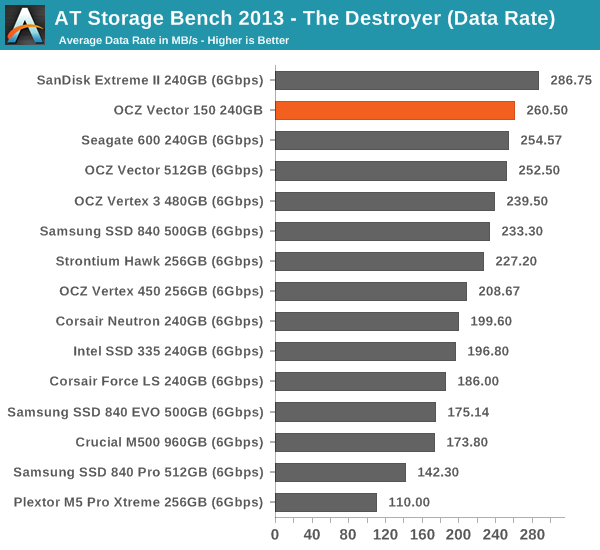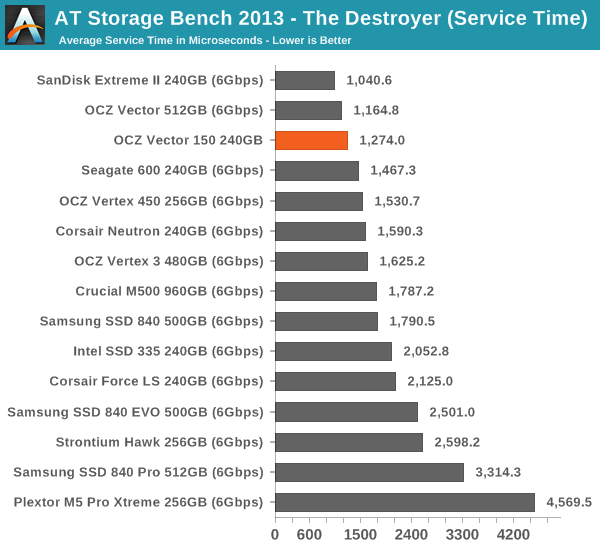OCZ Vector 150 (120GB & 240GB) Review
by Kristian Vättö on November 7, 2013 9:00 AM EST- Posted in
- Storage
- SSDs
- OCZ
- Indilinx
- Vector 150
AnandTech Storage Bench 2013
When Anand built the AnandTech Heavy and Light Storage Bench suites in 2011 he did so because we didn't have any good tools at the time that would begin to stress a drive's garbage collection routines. Once all blocks have a sufficient number of used pages, all further writes will inevitably trigger some sort of garbage collection/block recycling algorithm. Our Heavy 2011 test in particular was designed to do just this. By hitting the test SSD with a large enough and write intensive enough workload, we could ensure that some amount of GC would happen.
There were a couple of issues with our 2011 tests that we've been wanting to rectify however. First off, all of our 2011 tests were built using Windows 7 x64 pre-SP1, which meant there were potentially some 4K alignment issues that wouldn't exist had we built the trace on a system with SP1. This didn't really impact most SSDs but it proved to be a problem with some hard drives. Secondly, and more recently, we've shifted focus from simply triggering GC routines to really looking at worst-case scenario performance after prolonged random IO.
For years we'd felt the negative impacts of inconsistent IO performance with all SSDs, but until the S3700 showed up we didn't think to actually measure and visualize IO consistency. The problem with our IO consistency tests is that they are very focused on 4KB random writes at high queue depths and full LBA spans—not exactly a real world client usage model. The aspects of SSD architecture that those tests stress however are very important, and none of our existing tests were doing a good job of quantifying that.
We needed an updated heavy test, one that dealt with an even larger set of data and one that somehow incorporated IO consistency into its metrics. We think we have that test. The new benchmark doesn't even have a name, we've just been calling it The Destroyer (although AnandTech Storage Bench 2013 is likely a better fit for PR reasons).
Everything about this new test is bigger and better. The test platform moves to Windows 8 Pro x64. The workload is far more realistic. Just as before, this is an application trace based test—we record all IO requests made to a test system, then play them back on the drive we're measuring and run statistical analysis on the drive's responses.
Imitating most modern benchmarks Anand crafted the Destroyer out of a series of scenarios. For this benchmark we focused heavily on Photo editing, Gaming, Virtualization, General Productivity, Video Playback and Application Development. Rough descriptions of the various scenarios are in the table below:
| AnandTech Storage Bench 2013 Preview -- The Destroyer | ||||||||||||
| Workload | Description | Applications Used | ||||||||||
| Photo Sync/Editing | Import images, edit, export | Adobe Photoshop CS6, Adobe Lightroom 4, Dropbox | ||||||||||
| Gaming | Download/install games, play games | Steam, Deus Ex, Skyrim, Starcraft 2, BioShock Infinite | ||||||||||
| Virtualization | Run/manage VM, use general apps inside VM | VirtualBox | ||||||||||
| General Productivity | Browse the web, manage local email, copy files, encrypt/decrypt files, backup system, download content, virus/malware scan | Chrome, IE10, Outlook, Windows 8, AxCrypt, uTorrent, AdAware | ||||||||||
| Video Playback | Copy and watch movies | Windows 8 | ||||||||||
| Application Development | Compile projects, check out code, download code samples | Visual Studio 2012 | ||||||||||
While some tasks remained independent, many were stitched together (e.g. system backups would take place while other scenarios were taking place). The overall stats give some justification to what we've been calling this test internally:
| AnandTech Storage Bench 2013 Preview -- The Destroyer, Specs | |||||||||||||
| The Destroyer (2013) | Heavy 2011 | ||||||||||||
| Reads | 38.83 million | 2.17 million | |||||||||||
| Writes | 10.98 million | 1.78 million | |||||||||||
| Total IO Operations | 49.8 million | 3.99 million | |||||||||||
| Total GB Read | 1583.02 GB | 48.63 GB | |||||||||||
| Total GB Written | 875.62 GB | 106.32 GB | |||||||||||
| Average Queue Depth | ~5.5 | ~4.6 | |||||||||||
| Focus | Worst-case multitasking, IO consistency | Peak IO, basic GC routines | |||||||||||
SSDs have grown in their performance abilities over the years, so we wanted a new test that could really push high queue depths at times. The average queue depth is still realistic for a client workload, but the Destroyer has some very demanding peaks. When we first introduced the Heavy 2011 test, some drives would take multiple hours to complete it; today most high performance SSDs can finish the test in under 90 minutes. The Destroyer? So far the fastest we've seen it go is 10 hours. Most high performance SSDs we've tested seem to need around 12—13 hours per run, with mainstream drives taking closer to 24 hours. The read/write balance is also a lot more realistic than in the Heavy 2011 test. Back in 2011 we just needed something that had a ton of writes so we could start separating the good from the bad. Now that the drives have matured, we felt a test that was a bit more balanced would be a better idea.
Despite the balance recalibration, there's just a ton of data moving around in this test. Ultimately the sheer volume of data here and the fact that there's a good amount of random IO courtesy of all of the multitasking (e.g. background VM work, background photo exports/syncs, etc...) makes the Destroyer do a far better job of giving credit for performance consistency than the old Heavy 2011 test. Both tests are valid; they just stress/showcase different things. As the days of begging for better random IO performance and basic GC intelligence are over, we wanted a test that would give us a bit more of what we're interested in these days. As Anand mentioned in the S3700 review, having good worst-case IO performance and consistency matters just as much to client users as it does to enterprise users.
We're reporting two primary metrics with the Destroyer: average data rate in MB/s and average service time in microseconds. The former gives you an idea of the throughput of the drive during the time that it was running the Destroyer workload. This can be a very good indication of overall performance. What average data rate doesn't do a good job of is taking into account response time of very bursty (read: high queue depth) IO. By reporting average service time we heavily weigh latency for queued IOs. You'll note that this is a metric we've been reporting in our enterprise benchmarks for a while now. With the client tests maturing, the time was right for a little convergence.

Like the performance consistency test hinted, the Vector 150 is top notch in terms of performance. SanDisk's Extreme II remains unbeatable but the Vector is the second fastest SSD in our new Storage Bench 2013. The original Vector has better average service time, but keep in mind that we're dealing with different capacities (240GB vs 512GB) -- steady-state performance usually scales up a little with more NAND. However, the difference between Vector 150 and Vertex 450 is significant.











59 Comments
View All Comments
ssdpro - Thursday, November 7, 2013 - link
I really don't see how comparing a SSD purchase to suicide is relevant. Any component can fail at any time - it is not the end of life having a graphics card fizzle or SSD disappear. If anyone remembers when Anandtech reviewed the 840 Pro the sample died and then when they tested the replacement it died. It happens. http://www.anandtech.com/show/6328/samsung-ssd-840... I still buy and will buy Samsung, I have bought and will buy from OCZ.JellyRoll - Thursday, November 7, 2013 - link
Good luck with that.evonitzer - Friday, November 8, 2013 - link
As long as we're playing the anecdotal game, I bought a Vertex 2 and it failed, but allowed me to recover all the data from it. It was a little weird, but whatever. Reinstalled to it and it worked fine. Then I switched to a Vertex 4 and it has treated me well. So ...Samus - Friday, November 8, 2013 - link
I just don't get why people would consider an OCZ drive over the competition. It'd be like buying a Quantum Bigfoot, IBM Deskstar 75GXP or Conner S35-series drive, all of which either had storage, performance or price crowns of their time, but all well-known for their poor reliability, including their successors. All of these companies failed.Quantum was purchased by Maxtor who discontinued the Bigfoot, IBM was purchased by Hitachi (who struggled to get those GMR heads to work beyond the 60GXP) and Conner went bankrupt and the assets were ironically purchased by Quantum who liquidated everything but their tape-backup business.
TheWrongChristian - Friday, November 8, 2013 - link
The difference is that the Samsung samples were promptly fixed with a firmware update before it was released to retail. I'd have no faith in OCZ fixing such firmware issues, and the Samsung 840 Pro has gone on to be a solid dependable drive.These failures are almost always firmware bugs, I think SSD generally rarely physically fail (though I have no numbers to back that up) and OCZ don't have a stellar reputation in that department.
Not that OCZ will be around to honour the 5 year warranty anyway....
djscrew - Saturday, November 9, 2013 - link
i do have to agree, my revodrive takes forever to boot... gonna have to try that space thingweiran - Thursday, November 7, 2013 - link
Interesting SSD but at this price I think I'd rather have the Sandisk Extreme II.JellyRoll - Thursday, November 7, 2013 - link
Yes I agree. Sandisk had been around 25 years. Ocz will be lucky to be around for another three months, thier cash burn is ridiculous and they are running on fumes provided by loan sharks....which is why they are a penny stock, yet no one buys them. The reason they haven't been bought is that the barefoot is just a rebadged marvell controller.they have no ip.chubbypanda - Thursday, November 7, 2013 - link
SanDisk? Since 1988, but for how many years are in SSD business (very, very short time).JellyRoll - Friday, November 8, 2013 - link
Yes, but they have produced NAND since its introduction 25 years ago. That is experience, and longevity.